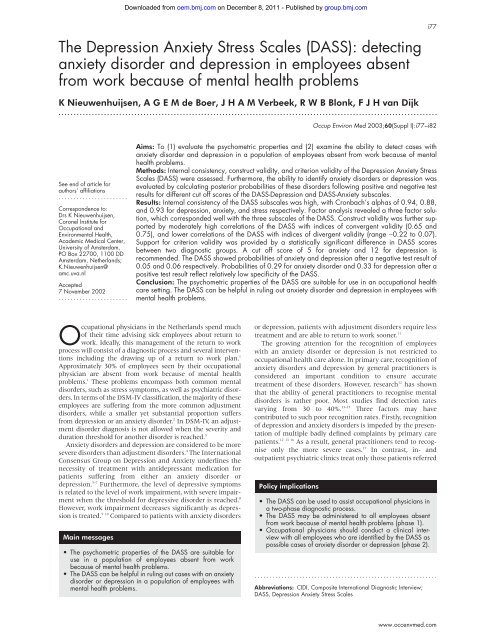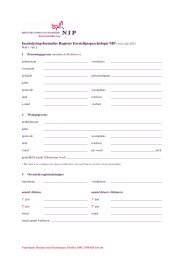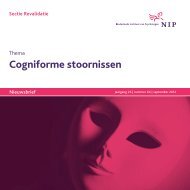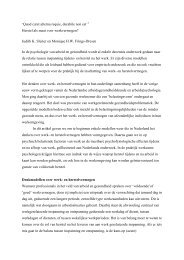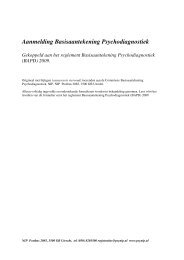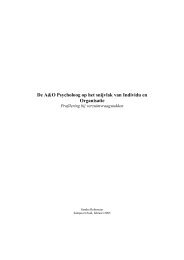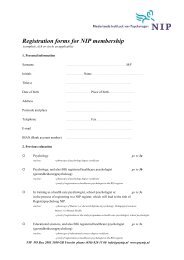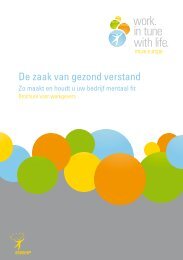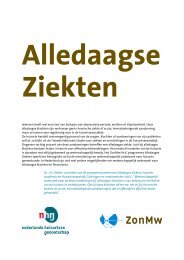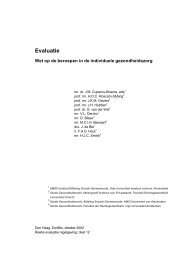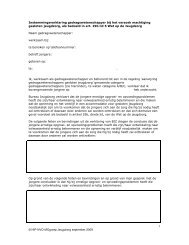The Depression Anxiety Stress Scales (DASS): detecting ... - NIP
The Depression Anxiety Stress Scales (DASS): detecting ... - NIP
The Depression Anxiety Stress Scales (DASS): detecting ... - NIP
Create successful ePaper yourself
Turn your PDF publications into a flip-book with our unique Google optimized e-Paper software.
Downloaded from oem.bmj.com on December 8, 2011 - Published by group.bmj.com<br />
<strong>The</strong> <strong>Depression</strong> <strong>Anxiety</strong> <strong>Stress</strong> <strong>Scales</strong> (<strong>DASS</strong>): <strong>detecting</strong><br />
anxiety disorder and depression in employees absent<br />
from work because of mental health problems<br />
i77<br />
K Nieuwenhuijsen, AGEMdeBoer, JHAMVerbeek, RWBBlonk, FJHvanDijk<br />
.............................................................................................................................<br />
Occup Environ Med 2003;60(Suppl I):i77–i82<br />
See end of article for<br />
authors’ affiliations<br />
.......................<br />
Correspondence to:<br />
Drs K Nieuwenhuijsen,<br />
Coronel Institute for<br />
Occupational and<br />
Environmental Health,<br />
Academic Medical Center,<br />
University of Amsterdam,<br />
PO Box 22700, 1100 DD<br />
Amsterdam, Netherlands;<br />
K.Nieuwenhuijsen@<br />
amc.uva.nl<br />
Accepted<br />
7 November 2002<br />
.......................<br />
Aims: To (1) evaluate the psychometric properties and (2) examine the ability to detect cases with<br />
anxiety disorder and depression in a population of employees absent from work because of mental<br />
health problems.<br />
Methods: Internal consistency, construct validity, and criterion validity of the <strong>Depression</strong> <strong>Anxiety</strong> <strong>Stress</strong><br />
<strong>Scales</strong> (<strong>DASS</strong>) were assessed. Furthermore, the ability to identify anxiety disorders or depression was<br />
evaluated by calculating posterior probabilities of these disorders following positive and negative test<br />
results for different cut off scores of the <strong>DASS</strong>-<strong>Depression</strong> and <strong>DASS</strong>-<strong>Anxiety</strong> subscales.<br />
Results: Internal consistency of the <strong>DASS</strong> subscales was high, with Cronbach’s alphas of 0.94, 0.88,<br />
and 0.93 for depression, anxiety, and stress respectively. Factor analysis revealed a three factor solution,<br />
which corresponded well with the three subscales of the <strong>DASS</strong>. Construct validity was further supported<br />
by moderately high correlations of the <strong>DASS</strong> with indices of convergent validity (0.65 and<br />
0.75), and lower correlations of the <strong>DASS</strong> with indices of divergent validity (range −0.22 to 0.07).<br />
Support for criterion validity was provided by a statistically significant difference in <strong>DASS</strong> scores<br />
between two diagnostic groups. A cut off score of 5 for anxiety and 12 for depression is<br />
recommended. <strong>The</strong> <strong>DASS</strong> showed probabilities of anxiety and depression after a negative test result of<br />
0.05 and 0.06 respectively. Probabilities of 0.29 for anxiety disorder and 0.33 for depression after a<br />
positive test result reflect relatively low specificity of the <strong>DASS</strong>.<br />
Conclusion: <strong>The</strong> psychometric properties of the <strong>DASS</strong> are suitable for use in an occupational health<br />
care setting. <strong>The</strong> <strong>DASS</strong> can be helpful in ruling out anxiety disorder and depression in employees with<br />
mental health problems.<br />
Occupational physicians in the Netherlands spend much<br />
of their time advising sick employees about return to<br />
work. Ideally, this management of the return to work<br />
process will consist of a diagnostic process and several interventions<br />
including the drawing up of a return to work plan. 1<br />
Approximately 30% of employees seen by their occupational<br />
physician are absent from work because of mental health<br />
problems. 1<br />
<strong>The</strong>se problems encompass both common mental<br />
disorders, such as stress symptoms, as well as psychiatric disorders.<br />
In terms of the DSM-IV classification, the majority of these<br />
employees are suffering from the more common adjustment<br />
disorders, while a smaller yet substantial proportion suffers<br />
from depression or an anxiety disorder. 2 In DSM-IV, an adjustment<br />
disorder diagnosis is not allowed when the severity and<br />
duration threshold for another disorder is reached. 3<br />
<strong>Anxiety</strong> disorders and depression are considered to be more<br />
severe disorders than adjustment disorders. 4 <strong>The</strong> International<br />
Consensus Group on <strong>Depression</strong> and <strong>Anxiety</strong> underlines the<br />
necessity of treatment with antidepressant medication for<br />
patients suffering from either an anxiety disorder or<br />
depression. 5–7 Furthermore, the level of depressive symptoms<br />
is related to the level of work impairment, with severe impairment<br />
when the threshold for depressive disorder is reached. 8<br />
However, work impairment decreases significantly as depression<br />
is treated. 910 Compared to patients with anxiety disorders<br />
Main messages<br />
• <strong>The</strong> psychometric properties of the <strong>DASS</strong> are suitable for<br />
use in a population of employees absent from work<br />
because of mental health problems.<br />
• <strong>The</strong> <strong>DASS</strong> can be helpful in ruling out cases with an anxiety<br />
disorder or depression in a population of employees with<br />
mental health problems.<br />
or depression, patients with adjustment disorders require less<br />
treatment and are able to return to work sooner. 11<br />
<strong>The</strong> growing attention for the recognition of employees<br />
with an anxiety disorder or depression is not restricted to<br />
occupational health care alone. In primary care, recognition of<br />
anxiety disorders and depression by general practitioners is<br />
considered an important condition to ensure accurate<br />
treatment of these disorders. However, research 12 has shown<br />
that the ability of general practitioners to recognise mental<br />
disorders is rather poor. Most studies find detection rates<br />
varying from 30 to 40%. 13–15 Three factors may have<br />
contributed to such poor recognition rates. Firstly, recognition<br />
of depression and anxiety disorders is impeded by the presentation<br />
of multiple badly defined complaints by primary care<br />
patients. 12 13 16 As a result, general practitioners tend to recognise<br />
only the more severe cases. 17<br />
In contrast, in- and<br />
outpatient psychiatric clinics treat only those patients referred<br />
Policy implications<br />
• <strong>The</strong> <strong>DASS</strong> can be used to assist occupational physicians in<br />
a two-phase diagnostic process.<br />
• <strong>The</strong> <strong>DASS</strong> may be administered to all employees absent<br />
from work because of mental health problems (phase 1).<br />
• Occupational physicians should conduct a clinical interview<br />
with all employees who are identified by the <strong>DASS</strong> as<br />
possible cases of anxiety disorder or depression (phase 2).<br />
.............................................................<br />
Abbreviations: CIDI, Composite International Diagnostic Interview;<br />
<strong>DASS</strong>, <strong>Depression</strong> <strong>Anxiety</strong> <strong>Stress</strong> <strong>Scales</strong><br />
www.occenvmed.com
Downloaded from oem.bmj.com on December 8, 2011 - Published by group.bmj.com<br />
i78<br />
Nieuwenhuijsen, de Boer, Verbeek, et al<br />
to them by general practitioners. <strong>The</strong>refore, psychiatric populations<br />
consist of patients with more severe and well defined<br />
symptoms than primary care populations. Secondly, the<br />
limited time available to general practitioners for assessment<br />
is deemed to contribute to low detection rates of depression<br />
and anxiety disorders. 18 <strong>The</strong> third reason for low recognition<br />
rates may be that general practitioners lack comprehensive<br />
diagnostic knowledge concerning psychopathology. 19<br />
It is likely that the same factors that impede the recognition<br />
of anxiety disorders and depression apply to occupational<br />
physicians since they see all employees who have been on sick<br />
leave for longer than about two weeks and there is no referral<br />
from another health care professional. Moreover, an average<br />
consultation with an occupational physician lasts approximately<br />
20 minutes, which is not substantially longer than the<br />
time spent by general practitioners. Finally, occupational physicians<br />
do not receive any more training in diagnosing<br />
psychopathology than general practitioners do.<br />
Considering these problems in identifying anxiety disorders<br />
and depression, it follows that a self administered instrument<br />
for case finding might prove helpful to occupational physicians.<br />
Such an instrument could be filled out by the employee<br />
prior to the consultation, thereby assisting occupational physicians<br />
in identifying employees with anxiety disorders and<br />
depression. One condition for implementation would be that<br />
this instrument is able to identify high risk cases within a<br />
group of patients similar to a primary care population.<br />
However, many of the validated instruments for use in<br />
primary health care either aim at reaching one specific<br />
diagnosis (for example, Goldberg screen for depression 20 )or<br />
are elaborate diagnostic instruments requiring specific training<br />
(for example, CIDI-PC, 21 PRIME-MD 22 ).<br />
<strong>The</strong> <strong>Depression</strong> <strong>Anxiety</strong> <strong>Stress</strong> <strong>Scales</strong> (<strong>DASS</strong>) 23 would seem<br />
to be a promising instrument for use in occupational health<br />
care. <strong>The</strong>oretically, this instrument corresponds with the<br />
tripartite model of anxiety and depression. 24 This model states<br />
that anxiety and depression possess unique features as well as<br />
common ones. <strong>Depression</strong> is uniquely characterised by low<br />
positive affect and anhedonia, while anxiety has physiological<br />
hyperarousal as a unique feature. <strong>Depression</strong> and anxiety have<br />
a non-specific factor of general distress in common. This general<br />
distress includes symptoms such as irritability and nervous<br />
tension, which are comparable to the symptoms reported<br />
by employees with adjustment disorders. 25<br />
<strong>The</strong>refore, the<br />
structure of the <strong>DASS</strong> seems to support the view that both<br />
anxiety disorders and depression need to be distinguished<br />
from adjustment disorders in spite of their communality.<br />
<strong>The</strong> psychometric properties of this instrument appear to be<br />
sound enough to be applied to both healthy and psychiatric<br />
populations. For these populations, the three factor solution<br />
has been determined by several authors. 26–30 Internal consistency<br />
of the three subscales ranged from 0.81 to 0.97. 27–29 Moreover,<br />
convergent and divergent validity have been shown to be<br />
satisfactory in these studies. 26 27 29 30 However, the <strong>DASS</strong> has not<br />
yet been studied in either a primary care or an occupational<br />
health care population. <strong>The</strong> aim of this study is therefore to<br />
evaluate the psychometric properties of the <strong>DASS</strong> in an occupational<br />
health care population. This study examines internal<br />
consistency, construct validity, and criterion validity of the<br />
<strong>DASS</strong>. A further aim of this study is to evaluate its ability to<br />
identify cases with an anxiety disorder or depression in this<br />
population.<br />
METHODS<br />
Participants<br />
As part of a longitudinal study on determinants of recovery and<br />
return to work in employees with mental health problems, 30<br />
occupational physicians from nine occupational health services<br />
provided data on patients seen over consecutive periods of one<br />
or more days a week. <strong>The</strong> following inclusion criteria needed to<br />
be met: the previous consultation with their occupational physician<br />
was longer ago than three months; a 100% absence from<br />
work; sickness absence because of mental health problems,<br />
defined as suffering from psychological symptoms that were<br />
not caused by a somatic disorder; and onset of sickness absence<br />
no longer than six weeks previously.<br />
From March 2001 until February 2002, data on 326<br />
employees with mental health problems were reported to us<br />
by the occupational physicians. Of these 326 employees, 32<br />
were excluded because they did not meet the inclusion criteria.<br />
Another 17 were excluded because they were unable to<br />
read Dutch (n = 2), were fully recovered (n = 5), were to be<br />
treated by another occupational physician (n = 6), were<br />
unable to fill out the questionnaire because of severe psychiatric<br />
problems (n = 2), or could not be contacted by telephone<br />
(n = 2).<br />
Of the remaining 277 patients eligible to participate in the<br />
study, 66 (24%) refused to participate. Of all 211 employees<br />
who signed an informed consent form, 198 filled out the<br />
questionnaire. Of these 198 employees included in this study,<br />
192 were interviewed. In the other six cases, the interview was<br />
not conducted because the participant could not be contacted<br />
by telephone.<br />
Procedure<br />
All participants were asked by their occupational physician to<br />
participate in the study. Each participant, after first having<br />
signed an informed consent form, was interviewed by the<br />
researchers via the telephone. Subsequently, questionnaires<br />
were sent to the participants by mail.<br />
Measures<br />
Participants were diagnosed by means of a short telephone<br />
version of the structured Composite International Diagnostic<br />
Interview (CIDI). 31<br />
An interview by telephone was used<br />
because of its convenience and its comparability with face to<br />
face interviews. 32–34<br />
<strong>The</strong> telephone interview included the<br />
following diagnostic groups: major depressive disorder, panic<br />
disorder, social phobia, somatoform disorder, bipolar disorder,<br />
obsessive-compulsive disorder, post-traumatic stress disorder,<br />
and psychotic disorder. For the first three diagnoses we<br />
administered the full CIDI scales, while we used only the stem<br />
(or screen) questions for the other categories. It was allowed<br />
for a participant to meet the criteria for more than one diagnosis.<br />
<strong>Anxiety</strong> disorder was operationalised as meeting the<br />
criteria for one or more of the following disorders: panic<br />
disorder, social phobia, somatoform disorder, obsessivecompulsive<br />
disorder, or post-traumatic stress disorder. <strong>Depression</strong><br />
was operationalised as meeting the criteria for major<br />
depressive disorder. All interviews were conducted or supervised<br />
by a mental health professional. All interviews were<br />
tightly scripted, including the use of standardised introductory<br />
statements. <strong>The</strong> length of the telephone interview varied<br />
from 15 to 20 minutes.<br />
Following the diagnostic interview, patients completed a<br />
self report questionnaire that comprised the <strong>DASS</strong>-42, the<br />
Hospital <strong>Anxiety</strong> and <strong>Depression</strong> Scale (HADS), 35<br />
and the<br />
Utrecht Coping List (UCL). 36 Participants respectively take 3, 7,<br />
and 10 minutes to complete the HADS, <strong>DASS</strong>, and the UCL.<br />
<strong>The</strong> <strong>DASS</strong>-42 consists of 42 symptoms divided into three subscales<br />
of 14 items: depression scale, anxiety scale, and stress<br />
scale. Participants rated the extent to which they had experienced<br />
each symptom over the previous week on a four point<br />
Likert scale ranging from 0 (did not apply to me at all) to 3<br />
(applied to me very much, or most of the time).<br />
In order to assess concurrent validity of the <strong>DASS</strong>,<br />
participants also completed the HADS. 35 <strong>The</strong> HADS is a 14<br />
item screening scale that measures the presence of anxiety<br />
and depressive states. It contains two seven-item subscales: a<br />
depression subscale and an anxiety subscale, each item being<br />
www.occenvmed.com
Downloaded from oem.bmj.com on December 8, 2011 - Published by group.bmj.com<br />
Detecting anxiety disorder and depression in employees<br />
i79<br />
scored on a four point scale (0–3). <strong>The</strong> HADS has been developed<br />
as a screen for <strong>detecting</strong> depressive and anxiety disorders<br />
in hospitalised patients. Items referring to symptoms that may<br />
have a physical cause (for example, weight loss or insomnia)<br />
are not included in the scale.<br />
To measure divergent validity, participants also filled out the<br />
UCL. 36<br />
<strong>The</strong> UCL is a Dutch questionnaire that measures<br />
habitual coping styles. This questionnaire consists of 47 statements<br />
concerning ways of coping with problems. <strong>The</strong> UCL<br />
comprises seven subscales measuring seven coping styles.<br />
Correlations between the <strong>DASS</strong> subscales and the subscales of<br />
“active problem solving” (UCL-Active), “seeking social support”<br />
(UCL-Social Sup), and “comforting cognitions” (UCL-<br />
Comf) served as indices for divergent validity in the analysis.<br />
Statistical analysis<br />
Cronbach’s alphas were calculated for each of the <strong>DASS</strong><br />
subscales in order to evaluate the internal consistency.<br />
To examine construct validity of the <strong>DASS</strong>, exploratory factor<br />
analyses were performed first. A principal component<br />
extraction was used, after which the number of factors was<br />
determined by both eigenvalues (>1) and the Scree test. 37 We<br />
applied a varimax rotation on this initial solution. To further<br />
examine construct validity, a correlational (Pearson’s) analysis<br />
of convergent and divergent validity was conducted by correlating<br />
the subscales of each of the three questionnaires. It was<br />
hypothesised that <strong>DASS</strong>-<strong>Depression</strong> would be moderately correlated<br />
to HADS-<strong>Anxiety</strong> and highly correlated to HADS-<br />
<strong>Depression</strong>. Furthermore, a high correlation between <strong>DASS</strong>-<br />
<strong>Anxiety</strong> and HADS-<strong>Anxiety</strong> was expected, while a moderate<br />
correlation between <strong>DASS</strong>-<strong>Anxiety</strong> and HADS-<strong>Depression</strong><br />
was hypothesised. <strong>DASS</strong>-<strong>Stress</strong> was expected to correlate<br />
moderately high with both HADS subscales. It was hypothesised<br />
that all three <strong>DASS</strong> subscales would show low correlations<br />
with the UCL subscales.<br />
In order to test concurrent validity of the <strong>DASS</strong>, a<br />
multivariate one way analysis of variance (MANOVA) was<br />
conducted. Employees were split into two diagnostic groups:<br />
one group with members suffering from an adjustment disorder<br />
and the other group with members suffering from a<br />
depression or anxiety disorder, as assessed by the CIDI interview.<br />
Employees with other disorders were excluded from this<br />
analysis. <strong>The</strong> analysis was conducted with group as betweensubject<br />
factor and the <strong>DASS</strong>-subscales as within-subjects factor.<br />
Tukey post hoc analyses were carried out in order to test<br />
differences for each of the subscales.<br />
Subsequently, we evaluated the ability to identify cases for<br />
the depression and anxiety subscales by using the CIDI interview<br />
as the gold standard. Sensitivity was determined by calculating<br />
the proportion of cases based on the <strong>DASS</strong> subscale<br />
among the cases according to the CIDI interview. Specificity<br />
was defined as the proportion of non-cases according to the<br />
<strong>DASS</strong> subscale among non-cases according to the CIDI.<br />
Furthermore, we calculated likelihood ratios for positive and<br />
negative test results. 38 Finally, we assessed posterior probabilities<br />
of the disorders following a positive test result (positive<br />
predictive value) or a negative test result (complement of<br />
negative predictive value) in our population for a range of cut<br />
off values.<br />
Considering the need for treatment of patients with an<br />
anxiety disorder or depression, false negative cases were<br />
regarded as more undesirable than false positive cases. <strong>The</strong>refore,<br />
we considered a negative likelihood ratio of 0.19 to be<br />
sufficient, which is comparable to the negative likelihood<br />
ratios found in a review of validated instruments for <strong>detecting</strong><br />
depression. 39<br />
Differences were tested at a significance level of p < 0.05.<br />
All data were analysed using the SPSS 10.0 software package.<br />
Table 1<br />
Characteristics of participants (n=198)<br />
Sociodemographic<br />
Gender, male–female 77–121<br />
Age, mean years (SD) 44 (9)<br />
Diagnosis<br />
Adjustment disorder 117<br />
<strong>Anxiety</strong> disorder 27<br />
<strong>Depression</strong> 30<br />
Both anxiety disorder and depression 14<br />
Other psychiatric disorder (i.e. psychotic or 4<br />
bipolar disorder)<br />
Unknown 6<br />
RESULTS<br />
Participants<br />
Table 1 presents the characteristics of the participants. Of the<br />
66 employees who refused to participate and the 49 that were<br />
excluded, 26 were male and 58 were female; the gender of 31<br />
was unknown. With respect to this variable, no significant<br />
difference (t test, p = 0.21) between the participants and<br />
non-participants was observed.<br />
Reliability<br />
Internal consistency of the <strong>DASS</strong> subscales was found to be<br />
high, with Cronbach’s alphas of 0.94, 0.88, and 0.93 for<br />
depression, anxiety, and stress subscales respectively.<br />
Factor analysis<br />
<strong>The</strong> three factor solution accounted for 53% of all variance,<br />
with eigenvalues of 16.2, 3.3, and 2.8. Table 2 shows factor<br />
loadings for the 42 items. <strong>The</strong> first factor that emerged<br />
consisted of all items from the depression scale plus one item<br />
(item 22) from the stress scale. <strong>The</strong> range of factor loadings<br />
(after varimax rotation) was 0.44 to 0.82. None of these items<br />
loaded higher than 0.40 on another factor. <strong>The</strong> second factor<br />
comprised 12 items from the stress scale plus one item from<br />
the anxiety scale (item 19), with eigenvalues ranging from<br />
0.38 to 0.83. Of these 13 items, one item (item 8) also loaded<br />
high (>0.40) on the depression factor and one item (item 39)<br />
loaded high (>0.40) on the anxiety factor. <strong>The</strong> final factor<br />
corresponded fairly well with the anxiety scale, with eigenvalues<br />
ranging from 0.39 to 0.78. All items from the anxiety scale,<br />
except item 19, loaded highest on this anxiety factor, while<br />
one item (item 33) from the stress scale loaded higher on this<br />
factor than on the stress factor (0.57 versus 0.41 respectively).<br />
Convergent and divergent validity<br />
Table 3 shows the correlations between the three <strong>DASS</strong><br />
subscales on the one hand and the indices for convergent and<br />
divergent validity on the other. As expected, table 3 reveals high<br />
correlations between both <strong>DASS</strong>-<strong>Anxiety</strong> and HADS-<strong>Anxiety</strong><br />
(r = 0.66) as well as between <strong>DASS</strong>-<strong>Depression</strong> and HADS-<br />
<strong>Depression</strong> (r = 0.75). Correlations between the <strong>DASS</strong>-<strong>Stress</strong><br />
scale and the HADS scales were moderately high (0.58 and<br />
0.60). This pattern of correlations confirms the hypothesis of<br />
good convergent validity. As can be seen from table 3, all three<br />
<strong>DASS</strong> scales showed low correlations (range −0.29 to 0.02) with<br />
the UCL subscales, indicating good divergent validity.<br />
Criterion validity<br />
Multivariate analysis of variance (MANOVA) revealed a<br />
significant overall effect of group (F = 17.25, df = 3.171,<br />
p < 0.001). Table 4 presents the mean scores and standard<br />
deviations of the <strong>DASS</strong> subscales for both employees with<br />
adjustment disorders and employees with a depression or<br />
anxiety disorder. <strong>The</strong> post hoc analyses showed that employees<br />
with a depression or anxiety disorder scored significantly<br />
higher on <strong>DASS</strong>-<strong>Depression</strong> (p < 0.001), <strong>DASS</strong>-<strong>Anxiety</strong><br />
www.occenvmed.com
Downloaded from oem.bmj.com on December 8, 2011 - Published by group.bmj.com<br />
i80<br />
Nieuwenhuijsen, de Boer, Verbeek, et al<br />
Table 2<br />
Factor structure of the <strong>DASS</strong> (n=198)<br />
Factor<br />
<strong>Depression</strong> <strong>Stress</strong> <strong>Anxiety</strong><br />
<strong>DASS</strong>-<strong>Depression</strong><br />
3 0.62 0.38 0.19<br />
5 0.49 0.32 0.18<br />
10 0.70 0.15 0.27<br />
13 0.57 0.29 0.22<br />
16 0.82 0.22 0.01<br />
17 0.65 0.31 0.17<br />
21 0.69 0.14 0.27<br />
24 0.78 0.21 0.11<br />
26 0.69 0.27 0.19<br />
31 0.77 0.27 0.11<br />
34 0.76 0.18 0.18<br />
37 0.80 0.14 0.22<br />
38 0.79 0.01 0.26<br />
42 0.67 0.20 0.21<br />
<strong>DASS</strong>-<strong>Anxiety</strong><br />
2 0.14 0.01 0.46<br />
4 0.15 0.22 0.41<br />
7 0.01 0.33 0.59<br />
9 0.20 0.13 0.73<br />
15 0.01 0.01 0.59<br />
19 0.22 0.38 0.25<br />
20 0.28 0.13 0.72<br />
23 0.18 0.01 0.53<br />
25 0.16 0.33 0.39<br />
28 0.13 0.25 0.78<br />
30 0.30 0.33 0.54<br />
36 0.30 0.01 0.73<br />
40 0.24 0.23 0.66<br />
41 0.01 0.28 0.54<br />
<strong>DASS</strong>-<strong>Stress</strong><br />
1 0.10 0.63 0.27<br />
6 0.15 0.79 0.19<br />
8 0.42 0.43 0.32<br />
11 0.24 0.63 0.37<br />
12 0.21 0.76 0.17<br />
14 0.19 0.63 0.18<br />
18 0.23 0.83 0.01<br />
22 0.44 0.37 0.25<br />
27 0.30 0.81 0.01<br />
29 0.25 0.61 0.39<br />
32 0.27 0.59 0.20<br />
33 0.32 0.41 0.57<br />
35 0.28 0.69 0.14<br />
39 0.31 0.51 0.43<br />
Bold indicates a factor loading of >0.40.<br />
(p < 0.001), and <strong>DASS</strong>-<strong>Stress</strong> (p < 0.01) compared to employees<br />
with adjustment disorders.<br />
Case finding<br />
<strong>The</strong> ability to identify employees with either a depression or an<br />
anxiety disorder was assessed for <strong>DASS</strong>-<strong>Depression</strong> and<br />
<strong>DASS</strong>-<strong>Anxiety</strong> respectively. Table 5 shows sensitivity and specificity<br />
rates for different cut off scores of these two subscales.<br />
Furthermore, table 5 shows both likelihood ratios for positive<br />
(LR+) and negative (LR−) test results as well as posterior<br />
probabilities of the disorders following positive or negative<br />
test results. As can be seen from this table, high sensitivity in<br />
identifying anxiety and depressive disorders results in<br />
relatively low specificity rates. If LR− is set at >0.19, then, for<br />
depression, the LR+ is 1.69, the posterior probability of a<br />
depression after a positive test result is 0.33. <strong>The</strong> posterior<br />
probability of a depression after a negative test result is 0.06.<br />
Given the same LR−, for anxiety, the LR+ is 1.53, the posterior<br />
probability of an anxiety disorder following a positive test<br />
result is 0.29, and 0.05 following a negative test result. Corresponding<br />
cut off scores would be 12 for <strong>DASS</strong>-<strong>Depression</strong> and<br />
5 for <strong>DASS</strong>-<strong>Anxiety</strong>.<br />
DISCUSSION<br />
<strong>The</strong> results of our study suggest that the psychometric properties<br />
of <strong>DASS</strong> are suited for use in a population of employees<br />
who are off work because of mental health problems. Internal<br />
consistency of the three <strong>DASS</strong> scales was high. Furthermore,<br />
the factor analysis revealed three factors, which yielded<br />
support for the construct validity of the <strong>DASS</strong>. In addition, all<br />
correlations of the <strong>DASS</strong> with indices of convergent and divergent<br />
validity were as predicted. <strong>The</strong> <strong>DASS</strong> showed good criterion<br />
validity since employees from different diagnostic groups<br />
differed in their score on the <strong>DASS</strong>. Low posterior probabilities<br />
of the disorders following a negative test result indicates that<br />
the <strong>DASS</strong> can be helpful in ruling out cases with an anxiety<br />
disorder or a depression. However, the relatively low probabilities<br />
of the disorders following a positive test result indicates a<br />
considerable rate of false positives.<br />
<strong>The</strong> psychometric properties of the <strong>DASS</strong> in our population<br />
are consistent with <strong>DASS</strong> studies in other populations. High<br />
internal consistency was observed in both student and clinical<br />
populations. 26 27 29 Moreover, both criterion and construct validity<br />
proved to be adequate in previous studies with student,<br />
clinical, and community samples. 26–30<br />
This indicates that the<br />
<strong>DASS</strong> can provide occupational physicians with detailed<br />
information on the level of depression, anxiety, and stress<br />
symptoms in their patients. Ours was the first study to evaluate<br />
the quality of the <strong>DASS</strong> in case findings of employees with an<br />
anxiety disorder or depression. Recently, Williams and colleagues<br />
published a review of case finding studies for<br />
depression 39 in primary care. <strong>The</strong>y found a median likelihood for<br />
a positive test result of 3.3 and a median likelihood for a negative<br />
test result of 0.19. Our study revealed similar likelihood<br />
ratios for a negative test result, but lower likelihood ratios for a<br />
positive test result for both anxiety disorder and depression.<br />
A unique feature of this study is that it evaluates the ability<br />
to detect anxiety disorder and depression among employees<br />
with mental health problems. Until now, most <strong>DASS</strong> studies<br />
addressed the distinction between subjects with and without<br />
an anxiety disorder or depression, while this study addressed<br />
the distinction between employees with adjustment disorders<br />
and those with an anxiety disorder or depression. This<br />
distinction is less clear cut, but is highly relevant for practice,<br />
while it has important consequences for the treatment of<br />
these employees. <strong>The</strong> <strong>DASS</strong> appears to be able to detect anxiety<br />
disorders and depression despite the communality in<br />
symptoms between these disorders and adjustment disorders.<br />
Caution is required when generalising these results across<br />
the entire occupational health care population. This study<br />
encompassed a population of employees with mental health<br />
problems who were absent from work. This entails that the<br />
prevalence of anxiety disorder and depression is substantially<br />
higher than in a general occupational health care population.<br />
Table 3<br />
Intercorrelations among <strong>DASS</strong> subscales and indices of convergent and divergent validity (n=198)<br />
<strong>DASS</strong>-D <strong>DASS</strong>-A <strong>DASS</strong>-S HADS-A HADS-D UCL-Active UCL-Soc Sup UCL-Comf<br />
<strong>DASS</strong>-D – 0.58** 0.65** 0.53** 0.75** −0.24** −0.29** −0.02<br />
<strong>DASS</strong>-A – 0.67** 0.66** 0.46** −0.29** −0.18* 0.002<br />
<strong>DASS</strong>-S – 0.60** 0.58** −0.08 −0.06 0.02<br />
*p
Downloaded from oem.bmj.com on December 8, 2011 - Published by group.bmj.com<br />
Detecting anxiety disorder and depression in employees<br />
i81<br />
Table 4 Comparisons of anxiety disorder/depression group with adjustment<br />
disorder group on the <strong>DASS</strong><br />
Adjustment disorder<br />
(n=117)<br />
<strong>Anxiety</strong> and/or<br />
depression (n=71)<br />
Group (n=188)<br />
Mean SD Mean SD<br />
Post hoc comparisons*<br />
<strong>DASS</strong>-<strong>Depression</strong> 12.91 8.7 20.63 9.7 Anx/depr>Adj<br />
<strong>DASS</strong>-<strong>Anxiety</strong> 7.73 6.4 13.98 8.2 Anx/depr>Adj<br />
<strong>DASS</strong>-<strong>Stress</strong> 17.43 9.5 21.22 8.5 Anx/depr>Adj<br />
*Tukey HSD test, all main effects significant at p
Downloaded from oem.bmj.com on December 8, 2011 - Published by group.bmj.com<br />
i82<br />
Nieuwenhuijsen, de Boer, Verbeek, et al<br />
can be described as process quality. Features such as<br />
acceptability for employees and logistical aspects determine<br />
the process quality of an instrument. Finally, the strategic<br />
quality of an instrument should be assessed. <strong>The</strong> presumed<br />
utility of the instrument defines this aspect of quality.<br />
<strong>The</strong> present study established the technical quality of the<br />
<strong>DASS</strong>. <strong>The</strong> process and strategic quality, however, still remain<br />
to be assessed. All employees in this study filled out the <strong>DASS</strong>,<br />
which is a tentative indication that the <strong>DASS</strong> is user friendly.<br />
This assumption should, however, be tested in a less motivated<br />
population—that is, not in a population of employees who<br />
agreed to participate in a cohort study. Whether the <strong>DASS</strong> can<br />
be implemented in occupational health care depends for a<br />
large part on logistic aspects of administering the <strong>DASS</strong>. One<br />
procedure could be that the <strong>DASS</strong> is administered to all<br />
employees with mental health problems prior to the consultation<br />
with the occupational physician. <strong>The</strong> occupational physician<br />
is then able to use the information from the <strong>DASS</strong> as an<br />
aid to his own diagnostic process. <strong>The</strong>se aspects of process<br />
quality and the utility of the <strong>DASS</strong> should be addressed in<br />
future implementation research. An important question is<br />
whether routinely administering the <strong>DASS</strong> prior to the<br />
consultation leads to a more accurate diagnosis of occupational<br />
physicians. Furthermore, the effect of the <strong>DASS</strong> on<br />
patient outcome also needs to be evaluated. Recognition of<br />
anxiety disorder and depression is a necessary, though not<br />
sufficient condition to improve outcome.<br />
In conclusion, the results of the present study suggest that<br />
the <strong>DASS</strong> is a valid instrument for use in occupational health<br />
care. It can be helpful in ruling out anxiety disorder and<br />
depression in employees with mental health problems.<br />
Furthermore, the <strong>DASS</strong> can be used to select employees in<br />
need of a more elaborate and accurate diagnostic process.<br />
ACKNOWLEDGEMENTS<br />
Grants were obtained from: <strong>The</strong> Netherlands Organization for Scientific<br />
Research (NWO): Netherlands Concerted Research Action<br />
“Fatigue at Work”; and the Foundation for Replacement and Occupational<br />
Health in Education (Stichting Vf/BGZ).<br />
.....................<br />
Authors’ affiliations<br />
K Nieuwenhuijsen, AGEMdeBoer, JHAMVerbeek,<br />
FJHvanDijk,Coronel Institute for Occupational and Environmental<br />
Health, Academic Medical Center, AmCOGG, University of Amsterdam,<br />
Netherlands<br />
R W B Blonk, TNO Work and Employment, Hoofddorp, Netherlands<br />
REFERENCES<br />
1 Schaufeli WB, Kompier MAJ. Managing job stress in the Netherlands.<br />
International Journal of <strong>Stress</strong> Management 2001;8:15–34.<br />
2 Veerman TJ, Schoemakers CG, Cuelenaere B, et al. Psychische<br />
arbeidsongeschiktheid [Work disability on mental health grounds].<br />
Doetinchem: Elsevier, 2002.<br />
3 American Psychiatric Association. Diagnostic and statistical manual of<br />
mental disorders, 4th edn. Washington, DC: APA, 1994.<br />
4 Casey P, Dowrick C, Wilkinson G. Adjustment disorders: fault line in the<br />
psychiatric glossary. Br J Psychiatry 2001;179:479–81.<br />
5 Ballenger JC, Davidson JR, Lecrubier Y, et al. Consensus statement on<br />
the primary care management of depression from the International<br />
Consensus Group on <strong>Depression</strong> and <strong>Anxiety</strong>. J Clin Psychiatry<br />
1999;60(suppl 7):54–61.<br />
6 Ballenger JC, Davidson JR, Lecrubier Y, et al. Consensus statement on<br />
social anxiety disorder from the International Consensus Group on<br />
<strong>Depression</strong> and <strong>Anxiety</strong>. J Clin Psychiatry 1998;59(suppl 17):54–60.<br />
7 Ballenger JC, Davidson JR, Lecrubier Y, et al. Consensus statement on<br />
panic disorder from the International Consensus Group on <strong>Depression</strong><br />
and <strong>Anxiety</strong>. J Clin Psychiatry 1998;59(suppl 8):47–54.<br />
8 Judd LL, Akiskal HS, Zeller PJ, et al. Psychosocial disability during the<br />
long-term course of unipolar major depressive disorder. Arch Gen<br />
Psychiatry 2000;57:375–80.<br />
9 Mintz J, Mintz LI, Arruda MJ, et al. Treatments of depression and the<br />
functional capacity to work. Arch Gen Psychiatry 1992;49:761–8.<br />
10 Simon GE, Barber C, Birnbaum HG, et al. <strong>Depression</strong> and work<br />
productivity: the comparative costs of treatment versus nontreatment.<br />
J Occup Environ Med 2001;43:2–9.<br />
11 Jones R, Yates WR, Williams S, et al. Outcome for adjustment disorder<br />
with depressed mood: comparison with other mood disorders. J Affect<br />
Disord 1999;55:55–61.<br />
12 Thompson C, Ostler K, Peveler RC, et al. Dimensional perspective on<br />
the recognition of depressive symptoms in primary care: <strong>The</strong> Hampshire<br />
<strong>Depression</strong> Project 3. Br J Psychiatry 2001;179:317–23.<br />
13 Tiemens BG, Ormel J, Simon GE. Occurrence, recognition, and outcome<br />
of psychological disorders in primary care. Am J Psychiatry<br />
1996;153:636–44.<br />
14 Docherty JP. Barriers to the diagnosis of depression in primary care.<br />
J Clin Psychiatry 1997;58(suppl 1):5–10.<br />
15 Thompson C, Kinmonth AL, Stevens L, et al. Effects of a clinical-practice<br />
guideline and practice-based education on detection and outcome of<br />
depression in primary care: Hampshire <strong>Depression</strong> Project randomised<br />
controlled trial. Lancet 2000;355:185–91.<br />
16 Ormel J, Tiemens BG. Recognition and treatment of mental illness in<br />
primary care. Towards a better understanding of a multifaceted problem.<br />
Gen Hosp Psychiatry 1995;17:160–4.<br />
17 Simon GE, Goldberg D, Tiemens BG, et al. Outcomes of recognized<br />
and unrecognized depression in an international primary care study.<br />
Gen Hosp Psychiatry 1999;21:97–105.<br />
18 Wittchen HU, Boyer P. Screening for anxiety disorders: Sensitivity and<br />
specificity of the <strong>Anxiety</strong> Screening Questionnaire (ASQ-15). Br J<br />
Psychiatry 1998;173:10–17.<br />
19 Tiemens BG, Ormel J, Jenner JA, et al. Training primary-care physicians<br />
to recognize, diagnose and manage depression: does it improve patient<br />
outcomes? Psychol Med 1999;29:833–45.<br />
20 Goldberg D, Bridges K, Duncan-Jones P, et al. Detecting anxiety and<br />
depression in general medical settings. BMJ 1988;297:897–9.<br />
21 Robins LN, Wing J, Wittchen HU, et al. <strong>The</strong> Composite International<br />
Diagnostic Interview. An epidemiologic Instrument suitable for use in<br />
conjunction with different diagnostic systems and in different cultures.<br />
Arch Gen Psychiatry 1988;45:1069–77.<br />
22 Spitzer RL, Williams JB, Kroenke K, et al. Utility of a new procedure for<br />
diagnosing mental disorders in primary care. <strong>The</strong> PRIME-MD 1000 study.<br />
JAMA 1994;272:1749–56.<br />
23 Lovibond SH, Lovibond PF. Manual for the <strong>Depression</strong> <strong>Anxiety</strong> <strong>Stress</strong><br />
<strong>Scales</strong> (<strong>DASS</strong>). University of New South Wales, 1993.<br />
24 Clark LA, Watson D. Tripartite model of anxiety and depression:<br />
psychometric evidence and taxonomic implications. J Abnorm Psychol<br />
1991;100:316–36.<br />
25 Klink JJL van der, Blonk RWB, Schene AH, et al. <strong>The</strong> effectiveness of an<br />
activating intervention for adjustment disorders with occupational<br />
dysfunctioning. Submitted.<br />
26 Antony MM, Bieling PJ, Cox BJ, et al. Psychometric properties of the<br />
42-item and 21-item versions of the <strong>Depression</strong> <strong>Anxiety</strong> <strong>Stress</strong> <strong>Scales</strong> in<br />
clinical groups and a community sample. Psychol Assessment<br />
1998;10:176–81.<br />
27 Brown TA, Chorpita BF, Korotitsch W, et al. Psychometric properties of<br />
the <strong>Depression</strong> <strong>Anxiety</strong> <strong>Stress</strong> <strong>Scales</strong> (<strong>DASS</strong>) in clinical samples. Behav<br />
Res <strong>The</strong>r 1997;35:79–89.<br />
28 Clara IP, Cox BJ, Enns MW. Confirmatory factor analysis of the<br />
<strong>Depression</strong>-<strong>Anxiety</strong>-<strong>Stress</strong> <strong>Scales</strong> in depressed and anxious patients.<br />
J Psychopathol Behav 2001;23:61–7.<br />
29 Beurs E de, Dyck R van, Marquenie LA, et al. De <strong>DASS</strong>: een vragenlijst<br />
voor het meten van depressie, angst en stress. [<strong>The</strong> <strong>DASS</strong>: a<br />
questionnaire for the measurement of depression, anxiety, and stress].<br />
Gedragstherapie 2001;34:35–53.<br />
30 Lovibond PF, Lovibond SH. <strong>The</strong> structure of negative emotional states:<br />
comparison of the <strong>Depression</strong> <strong>Anxiety</strong> <strong>Stress</strong> <strong>Scales</strong> (<strong>DASS</strong>) with the Beck<br />
<strong>Depression</strong> and <strong>Anxiety</strong> Inventories. Behav Res <strong>The</strong>r 1995;33:335–43.<br />
31 World Health Organization. Composite International Diagnostic<br />
Interview (CIDI), version 2.1. WHO, 1997.<br />
32 Simon GE, Revicki D, VonKorff M. Telephone assessment of depression<br />
severity. J Psychiatr Res 1993;27:247–52.<br />
33 Rohde P, Lewinsohn PM, Seeley JR. Comparability of telephone and<br />
face-to-face interviews in assessing axis I and II disorders. Am J Psychiatry<br />
1997;154:1593–8.<br />
34 Fenig S, Levav I, Kohn R, et al. Telephone vs face-to-face interviewing in<br />
a community psychiatric survey. Am J Public Health 1993;83:896–8.<br />
35 Zigmond AS, Snaith RP. <strong>The</strong> hospital anxiety and depression scale. Acta<br />
Psychiatr Scand 1983;67:361–70.<br />
36 Schreurs PJG, Tellegen B, Willige G van de, et al. De Utrechtse Coping<br />
Lijst: Handleiding [<strong>The</strong> Utrecht Coping List: Manual]. Lisse: Swets en<br />
Zeitlinger, 1988.<br />
37 Cattell RB. <strong>The</strong> scree test for the number of factors. Behav Res<br />
1966;1:245–76.<br />
38 Sackett DL, Haynes RB, Guyatt GH, et al. Clinical epidemiology; a basic<br />
science for clinical medicine. Boston: Little, Brown and Company, 1991.<br />
39 Williams JW Jr, Noel PH, Cordes JA, et al. Is this patient clinically<br />
depressed? JAMA 2002;287:1160–70.<br />
40 Dijk FJH van, Kort WL de, Verbeek JHAM. Quality assessment of<br />
occupational health services instruments. Occup Med 1993;43(suppl<br />
1):S28–33.<br />
www.occenvmed.com
Downloaded from oem.bmj.com on December 8, 2011 - Published by group.bmj.com<br />
<strong>The</strong> <strong>Depression</strong> <strong>Anxiety</strong> <strong>Stress</strong> <strong>Scales</strong> (<strong>DASS</strong>):<br />
<strong>detecting</strong> anxiety disorder and depression in<br />
employees absent from work because of<br />
mental health problems<br />
K Nieuwenhuijsen, A G E M de Boer, J H A M Verbeek, et al.<br />
Occup Environ Med 2003 60: i77-i82<br />
doi: 10.1136/oem.60.suppl_1.i77<br />
Updated information and services can be found at:<br />
http://oem.bmj.com/content/60/suppl_1/i77.full.html<br />
References<br />
Email alerting<br />
service<br />
<strong>The</strong>se include:<br />
This article cites 28 articles, 7 of which can be accessed free at:<br />
http://oem.bmj.com/content/60/suppl_1/i77.full.html#ref-list-1<br />
Article cited in:<br />
http://oem.bmj.com/content/60/suppl_1/i77.full.html#related-urls<br />
Receive free email alerts when new articles cite this article. Sign up in the<br />
box at the top right corner of the online article.<br />
Notes<br />
To request permissions go to:<br />
http://group.bmj.com/group/rights-licensing/permissions<br />
To order reprints go to:<br />
http://journals.bmj.com/cgi/reprintform<br />
To subscribe to BMJ go to:<br />
http://group.bmj.com/subscribe/


